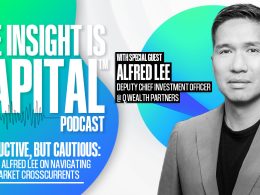Analyzing Prospective Client Portfolios in 4 Steps
by Commonwealth Financial Network
 Here's a scenario I think you'll be familiar with: at the end of a productive meeting, a prospective client hands you a pile of her current investment statements. You haven't yet secured her business, so analyzing these documents will be crucial in convincing the prospect to leave her current advisor. But what's the best way to approach this task?
Here's a scenario I think you'll be familiar with: at the end of a productive meeting, a prospective client hands you a pile of her current investment statements. You haven't yet secured her business, so analyzing these documents will be crucial in convincing the prospect to leave her current advisor. But what's the best way to approach this task?
Of course, there are many options available. But to simplify the process, here I've outlined four steps for analyzing prospective client portfolios. The goal is to get the data you need to continue your dialogue—and turn that prospect into a client.
The first—and possibly most important—step is to assess the prospect. Simply reviewing his or her investments in a vacuum limits the amount of value you can offer. Instead, look at the investments contextually, based on the prospect's current and future goals, risk tolerance, and time horizon. You can gather this information informally (e.g., taking notes during your meeting) or with a more formal approach (e.g., using a client intake form).
With the prospect's needs as your frame of reference, evaluate his or her current assets. Some information will be detailed on statements, but you might consider using a research tool, such as Morningstar® Advisor WorkstationSM, to gather additional data. Starting at a high level and drilling down, here are some topics and questions to review:
Overall asset allocation. What are the general equity and fixed income amounts and percentages? Are there alternative investments? Is this mix of equities, fixed income, and alternatives appropriate for the prospective client's goals and risk tolerance?
Asset class exposure. Is there appropriate diversification among the equity asset classes? Are the relative weights consistent with similar models you may use? Is the fixed income exposure weighted appropriately for the current and expected future interest rate environment?
Overweight/underweight sectors and regions. Is there a concentration in (or lack of exposure to) a particular industry or global territory? How does this affect the portfolio's risk profile?
Security type and tax. Is the prospect invested in mutual funds, exchange-traded funds, and stocks? Are there closed-end funds, unit investment trusts, or individual bonds with which you aren't familiar or experienced? Does the statement indicate any large taxable gains that should be addressed?
To take a deeper dive into investment characteristics, you'll want to use various metrics. I've highlighted a few here, but tailor your review to those most relevant to your potential client's situation.
Yield. How much income are the investments generating, and where is it coming from (equity dividends, fixed income interest, etc.)? Is this income level meeting the prospect's current needs? Will it be enough as his or her needs evolve?
Fixed income characteristics. Review the credit quality and effective duration measures. Are they appropriate for the current fixed income environment?
Fund review. Are the fund expenses reasonable? Do you have access to lower-cost versions of the same funds? How have the funds performed relative to their peers?
Modern portfolio theory (MPT) stats. Of course, you can get as deep into the weeds with MPT as you like. But I've narrowed it down to a few metrics that I believe are worth reviewing:
- Standard deviation (the portfolio's risk or volatility)
- Beta (the degree to which the portfolio moves in relation to a benchmark)
- Alpha (measure of a manager's performance beyond what can be attributed to following a benchmark)
Trailing returns. Once you've reviewed the portfolio's other characteristics, it's time to look at trailing returns. It may seem counterintuitive to review these last, but doing so can provide valuable perspective on the prospect's situation. It will give you a sense of what the expected returns should be and then confirm that performance is appropriate.
An effective way of finding opportunities is to tie together the client assessment and portfolio analysis. Look for any obvious disconnect between the prospective client's goals (and risk tolerance) and the asset characteristics. Simply put:
- Are these assets appropriate?
- Are the assets meeting the prospect's current and future goals?
To strengthen your case, identify any actual deficiencies, potential risks, or room for improvement. This might include, for example, the equity/fixed income mix, a particular asset class (or security) that is over- or underweight, insufficient income, excess risk, or high fund expenses.
But what if you find that the prospect's current investments are actually good? This may seem like a stumbling block, but it doesn't have to be! Avoid formulating a "story to tell" that just isn't there—you certainly don't want to make competing on performance your only value-add. Instead, be up front and honest with the potential client from the start, which will go a long way toward developing trust. After delivering the news that the prospect's investments are in good shape, you can lead the conversation in a few directions:
Plan for future goals. It may be that the current allocation has served the prospect well in the past. But now could be the time to adjust the investments to help meet goals going forward, especially if the prospect is nearing retirement.
Take profits and de-risk. The prospect's allocations may have performed well lately, in part due to the run-up in equities we've seen over the past decade. Consider locking in some of this growth and reallocating to de-risk the portfolio, in case the markets pull back and erase the gains.
Review internal fund expenses. If internal fund expenses are high, you may be able to offer lower-cost institutional shares of the same (or similar) funds. This way, the prospect's cost of ownership will be reduced.
These are just a few ways to articulate the value you can bring to a portfolio that's currently performing well. But don't forget that the investor is meeting with you for a reason—and it's most likely not related to investments or performance.
The research tells us that many clients decide to switch advisors based on service (or lack thereof). Specific reasons often cited include advisors not returning phone calls and e-mails in a timely manner and not being proactive in making contact. As such, personalized service and providing offerings that prospects aren't currently receiving—such as comprehensive financial planning—can be exactly what earns you their business. By performing a strategic assessment using the steps described above, you can demonstrate your value to the prospective client, no matter the state of his or her current investment portfolio.
What other steps do you take when analyzing prospective client portfolios? What are the common reasons clients give for changing advisors? Please share your thoughts with us below!
Editor's Note: This post was originally published in April 2015, but we've updated it to bring you more relevant and timely information.
Commonwealth Financial Network is the nation’s largest privately held independent broker/dealer-RIA. This post originally appeared on Commonwealth Independent Advisor, the firm’s corporate blog.
Copyright © Commonwealth Financial Network

















